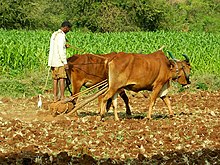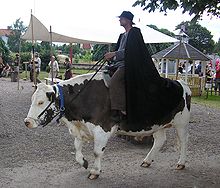As early as 9000 BC both grain and cattle were used as money or as
barter (Davies) (the
first grain remains found, considered to be evidence of pre-agricultural practice date to 17,000 BC).
[105][106][107] Some evidence also exists to suggest that other animals, such as
camels and
goats, may have been used as currency in some parts of the world.
[108] One of the advantages of using cattle as currency is that it allows the seller to set a fixed price. It even created the standard pricing. For example, two chickens were traded for one cow as cows were deemed to be more valuable than chickens.
[106]

This Hereford is being inspected for
ticks; cattle are often restrained or confined in
cattle crushes (squeeze chutes) when given medical attention.
Modern husbandry

This young bovine has a
nose ring to prevent it from suckling, which is usually to assist in
weaning.
Cattle are often raised by allowing herds to
graze on the grasses of large tracts of
rangeland. Raising cattle in this manner allows the use of land that might be unsuitable for growing crops. The most common interactions with cattle involve daily
feeding, cleaning and
milking. Many routine husbandry practices involve
ear tagging,
dehorning, loading,
medical operations, vaccinations and
hoof care, as well as training for agricultural shows and preparations. Also, some
cultural differences occur in working with cattle; the cattle husbandry of Fulani men rests on
behavioural techniques, whereas in Europe, cattle are controlled primarily by physical means, such as
fences.
[109] Breeders use cattle husbandry to reduce
M. bovis infection susceptibility by
selective breeding and maintaining herd health to avoid concurrent disease.
[110]
Cattle are farmed for beef, veal, dairy, and leather, and they are less commonly used for
conservation grazing, simply to maintain grassland for wildlife – for example, in
Epping Forest, England. They are often used in some of the most wild places for livestock. Depending on the breed, cattle can survive on hill grazing, heaths, marshes, moors and semidesert. Modern cattle are more commercial than older breeds and, having become more specialized, are less versatile. For this reason, many smaller farmers still favor old breeds, such as the
Jersey dairy breed. In Portugal, Spain,
southern France and some Latin American countries, bulls are used in the activity of
bullfighting;
Jallikattu in India is a bull taming sport radically different from European bullfighting, humans are unarmed and bulls are not killed. In many other countries bullfighting is illegal. Other activities such as
bull riding are seen as part of a
rodeo, especially in North America.
Bull-leaping, a central ritual in
Bronze Age Minoan culture (see
Bull (mythology)), still exists in southwestern
France. In modern times, cattle are also entered into
agricultural competitions. These competitions can involve live cattle or cattle carcases in hoof and hook events.
In terms of food intake by humans, consumption of cattle is less efficient than of grain or vegetables with regard to
land use, and hence cattle grazing consumes more area than such other agricultural production when raised on grains.
[111] Nonetheless, cattle and other forms of domesticated animals can sometimes help to use plant resources in areas not easily amenable to other forms of
agriculture.
Sleep
Further information:
Sleep (non-human)
The average sleep time of a domestic cow is about four hours a day.
[112]
Economy
 Holstein cattle
Holstein cattle are the primary dairy breed, bred for high milk production.
The
meat of adult cattle is known as
beef, and that of
calves is
veal. Other animal parts are also used as food products, including
blood,
liver,
kidney,
heart and
oxtail. Cattle also produce
milk, and
dairy cattle are specifically bred to produce the large quantities of milk processed and sold for human consumption. Cattle today are the basis of a multibillion-dollar industry worldwide. The
international trade in beef for 2000 was over $30 billion and represented only 23% of world beef production.
[113] The production of milk, which is also made into
cheese,
butter,
yogurt, and other dairy products, is comparable in economic size to beef production, and provides an important part of the food supply for many of the world's people. Cattle hides, used for
leather to make
shoes,
couches and
clothing, are another widespread product. Cattle remain broadly used as draft animals in many
developing countries, such as India. Cattle are also used in some sporting games, including
rodeo and
bullfighting.
Cattle meat production
Cattle meat production (kt)
2008 2009 2010 2011
Argentina 3132 3378 2630 2497
Australia 2132 2124 2630 2420
Brazil 9024 9395 9115 9030
China 5841 6060 6244 6182
Germany 1199 1190 1205 1170
Japan 520 517 515 500
USA 12163 11891 12046 11988
Source: Helgi Library,
[114] World Bank, FAOSTAT
About half the world's meat comes from cattle.
[115]
Dairy
Main articles:
Dairy cattle,
Dairy farming and
Dairy
Certain breeds of cattle, such as the
Holstein-Friesian, are used to produce milk,
[116][117] which can be processed into dairy products such as
milk,
cheese or
yogurt. Dairy cattle are usually kept on specialized dairy farms designed for milk production. Most cows are milked twice per day, with milk processed at a dairy, which may be onsite at the farm or the milk may be shipped to a dairy plant for eventual sale of a dairy product.
[118] For dairy cattle to continue producing milk, they must give birth to one calf per year. If the calf is male, it generally is slaughtered at a young age to produce
veal.
[119] They will continue to produce milk until three weeks before birth.
[117] Over the last fifty years, dairy farming has become more intensive to increase the yield of milk produced by each cow. The
Holstein-Friesian is the breed of dairy cow most common in the
UK,
Europe and the
USA. It has been bred selectively to produce the highest yields of milk of any cow. Around 22 litres per day is average in the UK.
[116][117]
Hides
Most cattle are not kept solely for hides, which are usually a by-product of beef production. Hides are most commonly used for
leather which can be made into a variety of product including shoes. In 2012 India was the world's largest producer of cattle hides.
[120]
Feral cattle
Feral cattle are defined as being 'cattle that are not domesticated or cultivated'.
[121] Populations of feral cattle are known to come from and exist in:
Australia,
United States of America,
Colombia,
Argentina,
Spain,
France and many islands, including
New Guinea,
Hawaii,
Galapagos,
Juan Fernández Islands,
Hispaniola (
Dominican Republic and
Haiti),
Tristan da Cunha and
Île Amsterdam.
[122]
her causes. It primarily affects dairy cattle and has been known to lower the quantity of milk produced, however the milk quality remains unaffected. Cattle are also susceptible to
ringworm caused by the fungus,
Trichophyton verrucosum, a contagious skin disease which may be transferred to humans exposed to infected cows.
[169]
Mycobacterium vaccae is a non pathogenic, possibly even beneficial bacteria, that is seen naturally in soil;
[170] that was first isolated from cow dung.
[171]
Oxen
Main article:
Ox

Draft
Zebus in
Mumbai,
Maharashtra, India
Oxen (singular
ox) are cattle trained as
draft animals. Often they are adult,
castrated males of larger breeds, although females and
bulls are also used in some areas. Usually, an
ox is over four years old due to the need for training and to allow it to grow to full size. Oxen are used for
plowing,
transport, hauling cargo, grain-grinding by trampling or by powering machines,
irrigation by powering pumps, and
wagon drawing. Oxen were commonly used to skid logs in forests, and sometimes still are, in low-impact, select-cut logging. Oxen are most often used in teams of two, paired, for light work such as
carting, with additional pairs added when more power is required, sometimes up to a total of 20 or more.

Oxen used in Plowing
An ox is a mature bovine which has learned to respond appropriately to a
teamster's signals. These signals are given by verbal commands or by noise (whip cracks). Verbal commands vary according to dialect and local tradition. In one tradition in North America, the commands are:[
citation needed]:
- "Back up": go backwards
- "Gee": turn right
- "Get up": walk forward
- "Haw": turn left
- "Whoa": stop

Riding an ox in
Hova, Sweden
Oxen can pull harder and longer than
horses. Though not as fast as horses, they are less prone to injury because they are more sure-footed.
Many oxen are used worldwide, especially in
developing countries. About 11.3 million draft oxen are used in sub-Saharan Africa.
[172] In India, the number of draft cattle in 1998 was estimated at 65.7 million head.
[173] About half the world's crop production is thought to depend on land preparation (such as plowing) made possible by animal traction.
[174]

The "Ure-Ox" (
Aurochs) by
Edward Topsell, 1658
NAILED IT!!!









